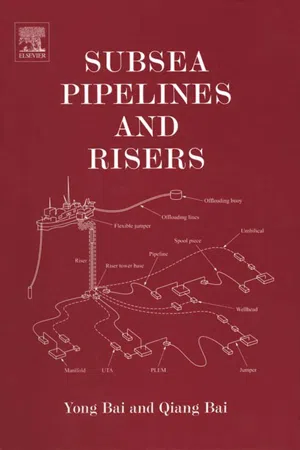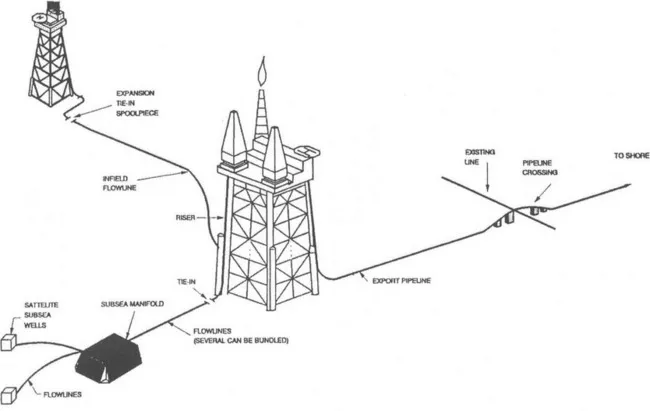
- 840 pages
- English
- ePUB (mobile friendly)
- Available on iOS & Android
eBook - ePub
About this book
• Updated edition of a best-selling title • Author brings 25 years experience to the work • Addresses the key issues of economy and environment Marine pipelines for the transportation of oil and gas have become a safe and reliable way to exploit the valuable resources below the world's seas and oceans. The design of these pipelines is a relatively new technology and continues to evolve in its quest to reduce costs and minimise the effect on the environment. With over 25years experience, Professor Yong Bai has been able to assimilate the essence of the applied mechanics aspects of offshore pipeline system design in a form of value to students and designers alike. It represents an excellent source of up to date practices and knowledge to help equip those who wish to be part of the exciting future of this industry.
Frequently asked questions
Yes, you can cancel anytime from the Subscription tab in your account settings on the Perlego website. Your subscription will stay active until the end of your current billing period. Learn how to cancel your subscription.
At the moment all of our mobile-responsive ePub books are available to download via the app. Most of our PDFs are also available to download and we're working on making the final remaining ones downloadable now. Learn more here.
Perlego offers two plans: Essential and Complete
- Essential is ideal for learners and professionals who enjoy exploring a wide range of subjects. Access the Essential Library with 800,000+ trusted titles and best-sellers across business, personal growth, and the humanities. Includes unlimited reading time and Standard Read Aloud voice.
- Complete: Perfect for advanced learners and researchers needing full, unrestricted access. Unlock 1.4M+ books across hundreds of subjects, including academic and specialized titles. The Complete Plan also includes advanced features like Premium Read Aloud and Research Assistant.
We are an online textbook subscription service, where you can get access to an entire online library for less than the price of a single book per month. With over 1 million books across 1000+ topics, we’ve got you covered! Learn more here.
Look out for the read-aloud symbol on your next book to see if you can listen to it. The read-aloud tool reads text aloud for you, highlighting the text as it is being read. You can pause it, speed it up and slow it down. Learn more here.
Yes! You can use the Perlego app on both iOS or Android devices to read anytime, anywhere — even offline. Perfect for commutes or when you’re on the go.
Please note we cannot support devices running on iOS 13 and Android 7 or earlier. Learn more about using the app.
Please note we cannot support devices running on iOS 13 and Android 7 or earlier. Learn more about using the app.
Yes, you can access Subsea Pipelines and Risers by Yong Bai,Qiang Bai in PDF and/or ePUB format, as well as other popular books in Technology & Engineering & Oceanography. We have over one million books available in our catalogue for you to explore.
Information
Part I
Mechanical Design
Chapter 1 Introduction
1.1 Introduction
Pipelines (and risers) are used for a number of purposes in the development of offshore hydrocarbon resources (see Figure 1.1). These include e.g.:
• Export (transportation) pipelines;
• Flowlines to transfer product from a platform to export lines;
• Water injection or chemical injection flowlines;
• Flowlines to transfer product between platforms, subsea manifolds and satellite wells;
• Pipeline bundles.

Figure 1.1 Use of flowlines offshore.
The design process for each type of lines in general terms is the same. It is this general design approach that will be discussed in this book.
Design of metallic risers is similar to pipeline design, although different analysis tools and design criteria are applied. Part IV of this book is devoted to riser design.
Finally, in Chapter 16, two pipeline design projects are used as examples demonstrating how technical development described in this book is used to achieve cost saving and safety/quality.
1.2 Design Stages and Process
1.2.1 Design Stages
The design of pipelines and risers is usually performed in three stages, namely;
• Conceptual engineering,
• Preliminary engineering or pre-engineering,
• Detail engineering.
The objective and scope of each of these design stages vary depending on the operator and the size of the project. However, the primary aims are generally as follows (Langford and Kelly (1990)):
1. Conceptual Engineering
The primary objectives are normally:
– To establish technical feasibility and constraints on the system design and construction;
– To eliminate non viable options;
– To identify the required information for the forthcoming design and construction;
– To allow basic cost and scheduling exercises to be performed;
– To identify interfaces with other systems planned or currently in existence.
The value of the early engineering work is that it reveals potential difficulties and areas where more effort may be required in the data collection and design areas.
2. Preliminary engineering or basic engineering
The primary objectives are normally:
– Perform pipeline design so that system concept is fixed. This will include:
• To verify the sizing of the pipeline;
• Determining the pipeline grade and wall thickness;
• Verifying the pipeline against design and code requirements for installation, commissioning and operation;
– Prepare authority applications;
– Perform a material take off sufficient to order the linepipe (should the pipe fabrication be a long lead item, hence requiring early start-up)
The level of engineering is sometimes specified as being sufficient to detail the design for inclusion into an “Engineering, Procurement, Construction and Installation” (EPCI) tender. The EPCI contractor should then be able to perform the detailed design with the minimum number of variations as detailed in their bid.
3. Detail engineering
The detailed engineering phase is, as the description suggests, the development of the design to a point where the technical input for all procurement and construction tendering can be defined in sufficient detail.
The primary objectives can be summarized as:
– Rou...
Table of contents
- Cover image
- Title page
- Table of Contents
- Ocean Engineering Series
- Copyright
- FOREWORD
- FOREWORD to “Pipeliners and Risers” Book
- PREFACE
- Part I: Mechanical Design
- Part II: Pipeline Design
- Part III: Flow Assurance
- Part IV: Riser Engineering
- Part V: Welding and Installation
- Part VI: Integrity Management
- SUBJECT INDEX